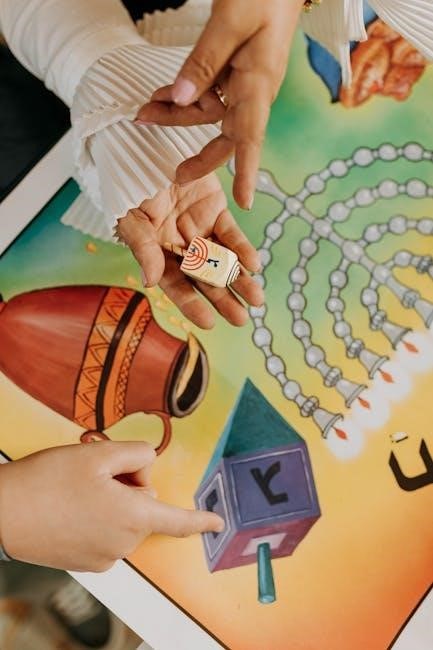The Hebrew alphabet, comprising 22 letters, is written from right to left. It is deeply rooted in history and religion, featuring prominently in the Bible and Jewish texts. PDF charts and worksheets are popular tools for learning, offering a structured approach to mastering these ancient letters.
Overview of the Hebrew Alphabet
The Hebrew alphabet consists of 22 letters, all of which are consonants, and is written from right to left. Unlike the English alphabet, it does not include vowel letters, though vowel sounds are represented by diacritical marks in some texts. Five of the letters have special final forms when they appear at the end of a word. The alphabet is deeply rooted in history and religion, playing a central role in Jewish texts and the Bible. Its structure and pronunciation have evolved over centuries, with modern Hebrew retaining the core elements of the ancient system. PDF charts and worksheets are widely used to help learners master the letters, making it easier to study and practice the alphabet systematically.
Importance of Learning Hebrew Letters
Learning Hebrew letters is essential for understanding the language, culture, and religious texts of the Jewish tradition. The Hebrew alphabet forms the foundation of Biblical studies, as Psalm 119 exemplifies, with each section dedicated to a letter. Knowledge of these letters enhances prayer and Torah study, connecting learners to their heritage. Additionally, mastering the alphabet aids in vocabulary expansion and proper pronunciation. PDF charts and worksheets provide structured resources for practice, making the learning process accessible and efficient. Whether for religious, educational, or cultural reasons, the Hebrew alphabet is a gateway to deeper engagement with Jewish identity and tradition.
Structure of the Hebrew Alphabet

The Hebrew alphabet consists of 22 letters, all of which are consonants, written from right to left. Five of these letters have distinct final forms when appearing at the end of a word. The alphabet is foundational to Jewish scripture and liturgy, with each letter holding historical and symbolic significance. Resources like PDF charts and worksheets are widely used to study the alphabet, offering clear visuals of both block and cursive scripts. These tools often include pronunciation guides and transliterations, aiding learners in mastering the letters. Understanding the structure of the Hebrew alphabet is crucial for reading and writing in Hebrew, as well as engaging with religious texts like the Torah and Psalms.

History of the Hebrew Alphabet
The Hebrew alphabet originated over 3,800 years ago, derived from Egyptian hieroglyphics. It evolved into the modern Hebrew script, with evidence of its ancient use found in religious texts and scholarly studies.
Origin and Evolution of Hebrew Letters
The Hebrew alphabet traces its origins to ancient Egyptian hieroglyphics, adapted over 3,800 years ago. Scholars, like Petrovich, suggest early Israelites converted hieroglyphs into a Semitic script. This early alphabet evolved into the Paleo-Hebrew script, later replaced by the Aramaic-inspired square Hebrew letters. Over millennia, the alphabet underwent minimal changes, retaining its 22-letter structure. The modern Hebrew alphabet, used today, reflects this enduring legacy, with its right-to-left script and distinctive letterforms. Its evolution is intertwined with religious and cultural history, as seen in ancient texts like the Bible and scholarly studies documenting its development.
Ancient Hebrew Alphabet Chart
The ancient Hebrew alphabet, comprising 22 letters, was written from right to left and descended from Egyptian hieroglyphs. Its earliest forms, such as Paleo-Hebrew, were used in biblical times. Over centuries, it evolved into the modern square script. Ancient charts highlight these letters, including their historical pronunciations and symbolic meanings. The alphabet’s structure and significance are detailed in religious texts like the Bible, where Psalm 119 uses each letter to begin its sections. PDF resources and worksheets provide learners with accessible tools to study these ancient letters, bridging history and modern education. These charts are invaluable for understanding the cultural and linguistic heritage of Hebrew.
Development of the Modern Hebrew Alphabet
The modern Hebrew alphabet evolved from the ancient Paleo-Hebrew script, influenced by the Aramaic alphabet during the Babylonian exile. Over centuries, it transitioned into the square script commonly used today. This development was crucial for reviving Hebrew as a spoken language in the 19th century. The modern alphabet retains the original 22 letters, with distinct forms for consonants and silent letters. PDF charts and educational resources detail this progression, offering insights into historical adaptations and linguistic revival. These materials are essential for learners seeking to understand the transformation from ancient to modern Hebrew, emphasizing its enduring cultural and religious significance.

Hebrew Alphabet Chart in PDF Format
Hebrew Alphabet Chart PDFs are available for free download, offering letter names, pronunciation guides, and printable worksheets. Ideal for beginners and educators alike, these resources simplify learning the Aleph-Bet;
Downloading Free Hebrew Alphabet Charts
Free Hebrew alphabet charts in PDF format are widely available online, offering a convenient way to learn the Aleph-Bet. These charts typically include the 22 Hebrew letters, their names, and pronunciation guides. Many resources provide printable versions, making them ideal for practice and study. Websites dedicated to Hebrew language learning often offer downloadable charts, along with graded worksheets for progressive skill-building. Additionally, educational platforms and marketplaces like Etsy feature customizable Hebrew alphabet PDFs, including flashcards and interactive exercises. These materials are perfect for beginners, educators, and self-learners alike, ensuring a structured approach to mastering the Hebrew script. Downloading these charts is a great first step in your Hebrew learning journey.
Features of a Hebrew Alphabet PDF
A Hebrew Alphabet PDF typically includes the 22 letters of the Aleph-Bet, showcasing both their block and cursive forms. Many PDFs feature transliterations and pronunciation guides to aid learners in mastering the sounds. Some documents include historical insights, tracing the evolution of the letters from ancient to modern times. Others incorporate practice exercises, such as writing drills and word formation activities. PDFs often cater to different learning styles, offering visual aids like charts and diagrams. Additionally, some resources provide theological context, highlighting the letters’ significance in religious texts like the Bible and Psalms. These comprehensive features make Hebrew Alphabet PDFs invaluable for both educational and personal use, ensuring a well-rounded learning experience.
How to Use a Hebrew Alphabet Chart for Learning
A Hebrew Alphabet Chart is an essential tool for beginners, providing a clear visual guide to the 22 letters. Start by familiarizing yourself with the letters’ names, shapes, and pronunciation, using the chart to practice writing and recognition. Focus on the direction of writing, as Hebrew is written from right to left. Use the chart to learn the distinctions between similar-looking letters and their pronunciation. Incorporate the chart into daily practice by tracing the letters and associating them with sounds. For advanced learning, use the chart to identify letters in words and phrases, gradually building your reading and writing skills. Regular review with the chart ensures consistent progress and mastery of the Hebrew script.

Hebrew Letters and Their Pronunciation
The Hebrew alphabet consists of 22 consonants, each with distinct sounds. Vowels are indicated by diacritics, guiding pronunciation. PDF charts often include transliterations to aid learners in mastering accurate intonation and letter-sound associations.
Learning the Sounds of Hebrew Letters
Mastering the sounds of Hebrew letters is essential for proper pronunciation. The Hebrew alphabet consists of 22 consonants, each with a unique sound. Vowels, though not written as letters, are indicated by diacritics, which guide pronunciation. PDF charts are invaluable tools, providing clear transliterations and audio guides to help learners. For example, the letter Aleph (∞) is silent, while Bet (ב) is pronounced as “b” or “v.” These resources often include practice exercises to reinforce learning. Regular practice with these materials ensures learners can recognize and reproduce the sounds accurately, laying a strong foundation for reading and speaking Hebrew fluently.
Consonants and Vowels in Hebrew
The Hebrew alphabet includes 22 consonants, each with distinct sounds, and no vowels as separate letters. Instead, vowels are indicated by diacritics, small marks placed below or above consonants. These diacritics, such as the sheva, hiriq, and kamatz, guide pronunciation. PDF charts often highlight these diacritics, aiding learners in mastering both consonants and vowel sounds. For instance, the letter Bet (ב) can be pronounced as “b” or “v,” depending on the accompanying vowel. This system ensures clarity and consistency, making it easier to learn and use the Hebrew alphabet effectively for reading and writing purposes.
Practice Exercises for Hebrew Pronunciation
Mastering Hebrew pronunciation involves consistent practice with exercises tailored to reinforce sound and intonation. PDF resources often include activities like matching Hebrew letters to their sounds, reading aloud, and repetition drills. These exercises help learners familiarize themselves with the unique characteristics of Hebrew, such as guttural sounds and vowel diacritics. Many Hebrew alphabet PDFs incorporate interactive elements, such as flashcards or audio clips, to aid in pronunciation practice. Additionally, exercises like reading Hebrew words and phrases aloud, guided by native speaker recordings, enhance fluency. Regular practice with these tools ensures accurate and confident pronunciation, making learning the Hebrew alphabet both effective and enjoyable.

Hebrew Alphabet for Beginners
Learning the Hebrew alphabet starts with mastering the 22 letters and their sounds. PDF resources provide step-by-step guides, graded worksheets, and visual aids to simplify the process for newcomers.
Step-by-Step Guide to Learning Hebrew Letters
Mastering the Hebrew alphabet begins with understanding its structure. Start by familiarizing yourself with the 22 letters, noting their names, shapes, and pronunciations. Begin with the foundational letters like Aleph and Bet, gradually progressing to more complex ones. Use PDF charts to visualize each letter’s block and cursive forms, essential for reading and writing. Practice writing each letter on worksheets, paying attention to proper stroke order. Listen to audio resources to perfect pronunciation, as many letters have distinct sounds. Incorporate flashcards for memorization and utilize interactive exercises for reinforcement. Regular practice, even for a few minutes daily, will ensure steady progress in learning the Hebrew alphabet effectively.
Hebrew Alphabet Worksheets for Beginners
Hebrew alphabet worksheets are essential tools for beginners, offering a structured approach to learning. These resources, often available in PDF format, provide a clear and organized way to practice reading and writing Hebrew letters. Worksheets typically include letter tracing exercises, matching games, and word formation activities to reinforce learning. Graded worksheets introduce letters progressively, ensuring a steady pace for mastery. They also often feature visual aids, such as charts and flashcards, to help memorize the shapes and sounds of each letter. By utilizing these worksheets, learners can build a strong foundation in the Hebrew alphabet, making the process engaging and effective for newcomers to the language.
Graded Worksheets for Progressive Learning
Graded worksheets for Hebrew letters are designed to cater to learners at different stages, ensuring a smooth progression from basic recognition to advanced writing skills. These resources, often available as PDFs, start with simple exercises like tracing letters and gradually introduce more complex tasks, such as forming words and sentences. They incorporate visual aids like charts and flashcards to reinforce memory. The structured approach allows learners to build confidence and mastery step-by-step, making the process both effective and engaging. By following the graded sequence, beginners can systematically improve their proficiency in the Hebrew alphabet, laying a solid foundation for further language study. This method ensures comprehensive understanding and retention of each letter’s form and pronunciation.

Hebrew Alphabet and Vocabulary
Mastering the Hebrew alphabet is the foundation for building vocabulary. Letters combine to form words, and understanding their sounds and structures aids in learning basic Hebrew phrases and sentences effectively.
Combining Letters to Form Words
Combining Hebrew letters to form words is essential for language mastery. Each letter has a distinct sound and role, and their arrangement follows specific rules. For instance, the letter Aleph is silent but serves as a consonant, while Beit introduces sounds like “b” or “v.” By practicing with PDF charts, learners can recognize letter patterns and syllable structures. This skill is crucial for reading and writing in Hebrew, enabling the formation of basic words like אָב (father) and אֵם (mother). Understanding letter combinations also aids in pronunciation and vocabulary expansion, making it a fundamental step in Hebrew language acquisition.
Basic Hebrew Vocabulary for Beginners
Mastering basic Hebrew vocabulary is a cornerstone of language learning. Common words like שָׁלוֹם (shalom) for “peace” or “hello” and תוֹדָה (toda) for “thank you” are essential. Learners can use PDF charts to practice writing and pronouncing these words. Simple phrases like מַה שָׁלוֹםְךָ? (How are you?) and אֲנִי טוֹב (I am good) are foundational. These resources often include transliterations, aiding pronunciation. By combining letters into meaningful words, beginners build a strong linguistic foundation, enabling effective communication in Hebrew.
Expanding Your Hebrew Vocabulary
Expanding your Hebrew vocabulary involves moving beyond basic words to more complex terms. PDF resources often include graded lists of common verbs, nouns, and phrases. For example, verbs like לִקְרוֹא (to read) and nouns like יוֹם (day) are essential. Flashcards and apps can complement PDF charts, offering interactive ways to memorize words. Learning in context, such as through sentences or short texts, enhances retention. Regular practice with exercises and quizzes helps reinforce new vocabulary. As you progress, explore idiomatic expressions and synonyms to enrich your language skills. Consistent exposure to Hebrew texts and conversations accelerates vocabulary growth, making communication more natural and fluent over time.

Hebrew Alphabet in Religious Texts
The Hebrew alphabet holds profound significance in religious texts, notably the Bible and Jewish scriptures. Each letter symbolizes spiritual concepts, as seen in Psalm 119, which is structured around the alphabet.
Hebrew Alphabet in the Bible
The Hebrew alphabet is central to the composition of the Bible, as the Old Testament was originally written in Hebrew. Each letter carries deep symbolic meaning, reflecting the language’s sacred origins. The Bible frequently highlights the significance of Hebrew letters, as seen in Psalm 119, which is structured into 22 sections, each corresponding to a letter of the Hebrew alphabet. This psalm glorifies the Torah and the divine wisdom embedded in the Hebrew script. The use of the Hebrew alphabet in biblical texts underscores its role as a vessel for spiritual and cultural heritage, connecting believers to ancient traditions and divine revelation.
Significance of Hebrew Letters in Jewish Texts
In Jewish texts, the Hebrew alphabet holds profound spiritual and cultural significance. Each letter is considered a vessel for divine wisdom, as seen in the Torah and other sacred writings. The Hebrew letters are often associated with mystical meanings, symbolizing the connection between the physical and spiritual worlds. In Kabbalah, the letters are believed to contain divine energies, and their combinations are thought to reflect the creation of the universe. Jewish texts, such as the Zohar, explore the deeper symbolism of each letter, emphasizing their role in conveying sacred truths. The study of Hebrew letters is not only about language but also about understanding the essence of Jewish identity and heritage.
Psalm 119 and the Hebrew Alphabet
Psalm 119, the longest Psalm in the Bible, is uniquely structured to reflect the Hebrew alphabet. It is divided into 22 sections, each corresponding to a letter of the Hebrew alphabet. Each section begins with a word that starts with that specific letter, showcasing the alphabetical order. This Psalm emphasizes the beauty and order of the Hebrew language, as well as its deep connection to Jewish and Christian spirituality. The structure of Psalm 119 highlights the significance of the Hebrew alphabet in religious texts, demonstrating how it serves as a framework for expressing devotion and wisdom. This unique arrangement makes it a powerful tool for studying the Hebrew letters and their spiritual meanings. PDF resources often include analyses of this Psalm to aid in understanding its alphabetical structure and theological depth.

Hebrew Alphabet in Modern Usage
The Hebrew alphabet remains vital in modern times, used in education, cultural practices, and religious texts. PDF charts and worksheets are widely used for teaching and learning, making the ancient letters accessible to new generations. This enduring use ensures the Hebrew alphabet stays relevant in contemporary Jewish life and education.
Hebrew Letters in Everyday Life
The Hebrew alphabet is not just a relic of ancient times; it plays an active role in modern daily life. From street signs in Israel to Jewish community centers worldwide, Hebrew letters are visible in various contexts. They are used in educational materials, religious rituals, and cultural events. PDF resources, such as charts and worksheets, are popular tools for teaching the alphabet, making it accessible to learners of all ages. Additionally, Hebrew letters are often incorporated into art, jewelry, and literature, showcasing their enduring significance. This integration into everyday life ensures that the Hebrew alphabet remains a vibrant part of Jewish heritage and identity.
Hebrew Alphabet in Educational Resources
Hebrew alphabet PDFs are widely used in educational settings to teach the fundamentals of the language. These resources often include charts, worksheets, and interactive exercises designed for both children and adults. Many educational institutions and language learners utilize these PDFs for their structured approach to learning Hebrew letters. They typically feature the Aleph-Bet, pronunciation guides, and practice exercises. Some resources also incorporate flashcards and quizzes to enhance memorization. These materials are particularly popular among educators and self-learners, as they provide a comprehensive and engaging way to master the Hebrew alphabet. Their availability online makes them accessible to anyone interested in learning Hebrew, regardless of their location or educational background.
Hebrew Letters in Cultural Contexts
Hebrew letters hold profound cultural significance, often appearing in art, literature, and religious traditions. Their unique shapes and historical roots make them a symbol of Jewish identity. In cultural contexts, Hebrew letters are frequently used in calligraphy, jewelry, and decorative items, celebrating their aesthetic and spiritual value. They also feature in traditional rituals, such as the writing of Torah scrolls and mezuzahs. Additionally, Hebrew letters are central to Jewish education, reinforcing cultural heritage. PDF resources, like charts and worksheets, are widely used to teach these letters, ensuring their preservation for future generations. Their cultural importance extends beyond language, representing a connection to history and faith.

Hebrew Alphabet Practice Materials
PDF charts, worksheets, and graded materials provide structured practice for mastering Hebrew letters. Interactive exercises and flashcards enhance learning, ensuring effective retention of the alphabet.
PDF Worksheets for Hebrew Alphabet Practice
PDF worksheets are an excellent resource for practicing the Hebrew alphabet, offering a structured approach to learning. These documents typically include letter tracing exercises, matching games, and writing drills. They often feature the 22 letters of the Hebrew alphabet, along with their names and pronunciation guides. Many worksheets are designed for beginners, introducing letters gradually to build familiarity and confidence. Some PDFs also include visual aids, such as charts comparing ancient and modern letterforms, while others focus on cursive scripts. Additionally, PDFs may incorporate biblical references, linking letters to their significance in religious texts like Psalm 119. These tools are versatile, suitable for both self-study and classroom environments, ensuring comprehensive practice and mastery of the Hebrew alphabet.
Interactive Hebrew Alphabet Exercises
Interactive exercises enhance the learning of the Hebrew alphabet by engaging users through digital tools and activities. These exercises often include clickable flashcards, letter-matching games, and audio clips for pronunciation practice. Some resources allow users to write letters virtually, providing immediate feedback on accuracy. Interactive PDFs may feature quizzes to test knowledge retention, while online platforms offer real-time tracking of progress. These dynamic tools cater to various learning styles, making the process enjoyable and effective. They are particularly useful for those who prefer hands-on learning and wish to complement traditional study methods with modern, interactive approaches to master the Hebrew alphabet.
Hebrew Alphabet Flashcards for Memorization
Hebrew alphabet flashcards are an effective tool for memorizing the 22 letters of the Hebrew script. These flashcards typically feature the letter on one side and its pronunciation, name, and transliteration on the other. They are designed to help learners associate each letter with its sound and written form. Flashcards can be downloaded as PDFs, printed, or used digitally through interactive apps. Many sets include visual cues, such as block and cursive forms, to aid recognition. By regularly reviewing the flashcards, learners can build familiarity with the letters and improve retention. This method is particularly useful for beginners, as it allows for self-paced study and repetition, making memorization of the Hebrew alphabet both efficient and engaging.
The Hebrew alphabet, with its rich history and cultural significance, offers a foundational path to understanding Hebrew language and heritage. PDF resources provide accessible tools for learners to master these ancient letters effectively.
The Hebrew alphabet consists of 22 letters, all of which are consonants. It is written from right to left and has been used for centuries in religious texts like the Bible. The letters have both block and cursive forms, with five letters having special final forms. Resources such as PDF charts and worksheets are widely available, providing structured learning tools. These materials often include pronunciation guides and exercises, making them ideal for beginners. The alphabet’s significance extends beyond language, playing a central role in Jewish culture and heritage. Mastery of these letters is essential for understanding Hebrew texts and vocabulary.
Final Tips for Mastering Hebrew Letters
Consistent practice is key to mastering the Hebrew alphabet. Start with PDF charts and graded worksheets to build familiarity with the letters and their forms. Focus on pronunciation by listening to native speakers and practicing daily. Use flashcards to memorize each letter’s name, shape, and sound. Pay special attention to the five letters with final forms, as they differ when appearing at the end of words. Regularly review and write the letters to improve handwriting and recognition. Incorporate vocabulary exercises to see letters in context, enhancing retention. Stay motivated by setting achievable goals and celebrating progress. With dedication and the right resources, mastering the Hebrew alphabet becomes an attainable and rewarding journey.
Resources for Further Learning
For deeper exploration of the Hebrew alphabet, numerous resources are available online. Downloadable PDF charts provide clear visuals of all 22 letters, including their names, shapes, and pronunciations. Websites like HebrewforChristians offer comprehensive guides, while platforms like HebrewPod101 include audio aids for pronunciation practice. Books such as The Complete Hebrew Alphabet by T.Kigel offer in-depth insights. Additionally, educational apps and interactive tools allow for hands-on learning. Flashcards, graded worksheets, and vocabulary exercises can be found in PDF formats, ideal for progressive learning. Utilize these resources consistently to reinforce your understanding and improve retention of the Hebrew letters and their cultural significance.
